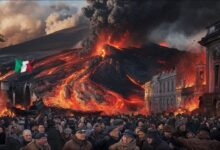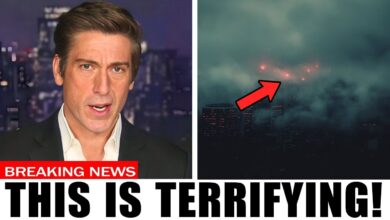What This Camera Captured in Russia Shocked the Whole World

The video titled “What This Camera Captured in Russia Shocked the Whole World” explores various unusual phenomena in the sky, focusing on strange images and events that often leave people in awe. One of the key moments discussed is an image captured in Russia, which some believe depicts an extraterrestrial craft, or a UFO.
However, the video suggests that this image is likely a cloud formation, not a spaceship. Despite the sensational claims, there is no solid proof to support the idea that it was a UFO, and the global reaction wasn’t as shocking as the title implies.
In fact, if this were a world-changing event, it would have been widely discussed, similar to other famous UFO incidents like Roswell or Area 51. Instead, the image is simply an intriguing yet unverified phenomenon that fuels ongoing speculation.
The video then transitions into other sky phenomena, explaining rare and visually striking events like mamus clouds, fire rainbows, and morning glory clouds. Each of these phenomena is a natural occurrence, often caused by specific atmospheric conditions, such as the interaction of light with ice crystals in the atmosphere.
The video emphasizes how many of these events, while fascinating, are often misunderstood or mistaken for something extraordinary. Ultimately, it invites viewers to appreciate the beauty and unpredictability of the natural world, while maintaining a healthy skepticism about claims of extraterrestrial involvement.
Lenticular clouds are unique because they are stationary, unlike most clouds that move with the wind. These clouds form in a way that causes them to remain in place, often appearing as large, saucer-shaped formations above mountains or cities.
Due to their stationary and puffy nature, some people mistakenly think these clouds are UFOs, which, though understandable, is a misconception. The stationary shape of the cloud should have been a clear indication that it wasn’t an extraterrestrial craft.
Moving on from clouds, let’s discuss ball lightning, one of the most mysterious and unexplained phenomena. Ball lightning is a rare event where lightning forms into a spherical shape, which is unlike any typical lightning bolt.
Although there are confirmed reports and even videos of ball lightning, its exact formation and why it occurs in this unique shape remain a mystery. These glowing spheres can explode, releasing sulfuric smells and causing damage. Ball lightning tends to appear during thunderstorms, but we still lack the ability to reliably reproduce or fully explain it.
Another rare phenomenon is the red sprite, a type of upward lightning discharge that occurs above thunderclouds, sometimes as high as 90 km above the Earth’s surface. Unlike typical lightning that strikes downwards, red sprites glow red and are brief but unforgettable.
These strange lightning events are just one of many variations in lightning behavior, and their rarity makes them even more fascinating.
Meteors and meteorites are well-known and often taught in school. A meteor is a chunk of rock traveling through space, and when it enters the Earth’s atmosphere, it breaks up into smaller pieces called meteorites. Most of the time, these smaller rocks burn up before reaching the ground, but in rare cases, they survive and can cause significant damage if they strike Earth.
A supernova occurs when a star reaches the end of its life and explodes, releasing a tremendous amount of energy. While this phenomenon is not something we witness directly, NASA and other space agencies capture images and footage of supernovas using telescopes. These explosions can result in the creation of black holes or the fading of the star into nothingness, depending on the circumstances.
Noctilucent clouds are another fascinating sight, visible during astronomical twilight. These clouds shine brightly against the dark sky, illuminated by the sun’s rays reflecting off them. They are so faint that they’re typically not visible during the day but can be breathtaking when observed at night.
Comets are different from meteors, as they are made of ice and dust. Unlike meteors, which follow their own paths, comets are influenced by the gravity of nearby stars. A well-known example is Halley’s Comet, which orbits our solar system and is visible from Earth roughly every 75 years.
Lightning elves are upper-atmosphere lightning events that occur far above typical thunderstorms. These brief flashes of light, observed in the mesosphere, are caused by massive electrical discharges that send electromagnetic pulses into the atmosphere. They highlight the complexity of atmospheric lightning phenomena.
Red rain, or “blood rain,” is another rare occurrence where rain appears red. While some might speculate supernatural causes, scientists have found that the phenomenon is often caused by red dust or dirt from the Earth’s surface getting into the atmosphere and mixing with rain.
Finally, virga is a phenomenon where rain evaporates before it reaches the ground. This happens when the rain encounters dry air or wind conditions that cause it to evaporate mid-fall. These “dry storms” are relatively rare but incredibly interesting when they occur.
Each of these phenomena offers a unique glimpse into the mysteries of our natural world. Some are still not fully understood, and others continue to challenge our perception of the sky. Whether or not we fully grasp their causes, they remain some of the most captivating and bizarre occurrences to witness.








